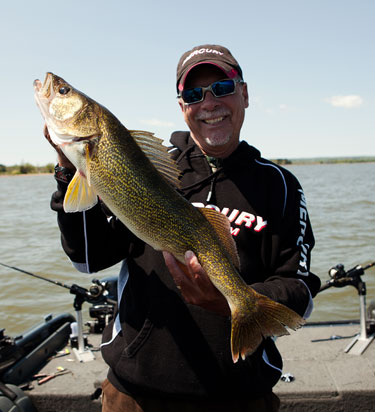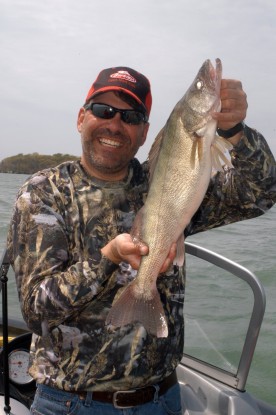To make this trip a success, you’ve got to have a game plan to find and catch walleyes as efficiently as possible. As tournament anglers, we face that dilemma every time we arrive at a new tournament location. Thankfully, over the years we’ve developed a system that can help you spend your well deserved vacation time catching plenty of mid-summer walleyes instead of just fishing for them.
 Well, it’s that time of year again; Mid-summer; the most popular time of year for taking some time off from the daily grind and enjoying that tradition we call “vacation”. Of course, if you’re a walleye nut like us, summer vacations are typically planned to include plenty of fishing. The challenge to such a trip however is you’ve got about one week to get to your fishing destination, learn the body of water, find the fish, and determine the best presentation for putting a mess of walleyes in the boat before it’s time to head back home. While that doesn’t seem like such a daunting task, start adding in such variables as travel time, changing weather patterns, and family members with other vacation agendas, and the time you’re left with to actually fish begins to dwindle to just a few precious, and often all-too-short days.
Well, it’s that time of year again; Mid-summer; the most popular time of year for taking some time off from the daily grind and enjoying that tradition we call “vacation”. Of course, if you’re a walleye nut like us, summer vacations are typically planned to include plenty of fishing. The challenge to such a trip however is you’ve got about one week to get to your fishing destination, learn the body of water, find the fish, and determine the best presentation for putting a mess of walleyes in the boat before it’s time to head back home. While that doesn’t seem like such a daunting task, start adding in such variables as travel time, changing weather patterns, and family members with other vacation agendas, and the time you’re left with to actually fish begins to dwindle to just a few precious, and often all-too-short days.
To make this trip a success, you’ve got to have a game plan to find and catch walleyes as efficiently as possible. As tournament anglers, we face that dilemma every time we arrive at a new tournament location. Thankfully, over the years we’ve developed a system that can help you spend your well deserved vacation time catching plenty of mid-summer walleyes instead of just fishing for them.
First off, try to make your vacation destination a place where the walleye population is strong and plentiful. Throughout the walleye belt there are numerous places to choose from, so there really is no need to travel a long way from home. That’ll save on both travel time and the all-important fuel budget. Next, do a little “pre-trip” research. Area bait shops, fisheries departments and resorts can all be good sources of info on what’s happening on that body of water. The internet is another great source of information. It’s possible to get weekly updated fishing reports on many of the country’s popular walleye fishing destinations, and walleye fishing chat rooms can put you in touch with other anglers more familiar with the area you’re going to be fishing. Having a map of the lake is essential. Familiarize yourself with the body of water, and mark potential “hot-spots” you find in your research.
Once you’re on the water, the real fun begins. If you’ve done your research, you’ve got a few ideas of the areas and spots you’ll want to check out, but to be as efficient as possible, make sure you’re not fishing a spot that’s devoid of fish. As professional anglers, we rely heavily on our electronics to locate potentially fishable areas before we actually start fishing. The locators we use are the Lowrance HDS-10 and HDS-8 Gen2 Fishfinder/Chartplotters. These are high-end units that not only give you the best in sonar capability, but also can be rigged with features like Lowrance’s StructureScan, giving you every possible advantage when it comes to seeing what’s below the surface. These units are sonar/GPS combo units, and a GPS can be invaluable when it comes to fishing new water. Using the GPS in conjunction with your lake map, it is easy to find your way to those hot spots you learned about earlier in your research, not to mention, it will help you to find your way around (and back to the boat ramp) on a strange body of water.
 When you’ve found your fishing spot, it’s time to go to work and catch some fish. Mid-summer usually means you’re dealing with active fish, so presentations like trolling crankbaits or bottom bouncer-spinner rigs will allow you to cover water quickly and efficiently looking for active biters. Moderate action crankbaits like the Berkley Flicker Shads are great summertime baits. They have an enticing action and a load rattle that can call in fish looking for an easy meal. The crankbait patterns most typical for this time of year will be contour trolling, and open water trolling. If the fish are relating directly to structure, be it points or flats, then trolling the contour at the depth most fish are being marked is a deadly and effective tactic. On the other hand, if the walleyes are relating to schools of open water baitfish, and out over the basins, open water techniques incorporating Off Shore Tackle OR-12 Side-Planer boards to spread out the lures and really cover some water will put a lot of fish in the boat. Remember, even in the open water scenarios, it’s important to key in on the depth that most of the fish are feeding at. You may mark fish throughout the water column, but by running lures at various depths to start with, it will quickly become apparent at what depth they’re feeding.
When you’ve found your fishing spot, it’s time to go to work and catch some fish. Mid-summer usually means you’re dealing with active fish, so presentations like trolling crankbaits or bottom bouncer-spinner rigs will allow you to cover water quickly and efficiently looking for active biters. Moderate action crankbaits like the Berkley Flicker Shads are great summertime baits. They have an enticing action and a load rattle that can call in fish looking for an easy meal. The crankbait patterns most typical for this time of year will be contour trolling, and open water trolling. If the fish are relating directly to structure, be it points or flats, then trolling the contour at the depth most fish are being marked is a deadly and effective tactic. On the other hand, if the walleyes are relating to schools of open water baitfish, and out over the basins, open water techniques incorporating Off Shore Tackle OR-12 Side-Planer boards to spread out the lures and really cover some water will put a lot of fish in the boat. Remember, even in the open water scenarios, it’s important to key in on the depth that most of the fish are feeding at. You may mark fish throughout the water column, but by running lures at various depths to start with, it will quickly become apparent at what depth they’re feeding.
Every year more and more anglers are catching on to the simplicity and effectiveness of bottom bouncer fishing, and summertime is spinner time when it comes to bouncers. Bottom Bouncer Spinner rigs don’t cover water quite as fast as cranks, but when walleyes are in a less active to neutral mode, nothing trips their trigger like a spinner tipped with a crawler. Bottom Bouncer Spinner fishing excels when fish are relating to main lake flats or feeding shelves on main lake points. The best set up for this is to use your bowmount electric and keep the speed just fast enough to get the spinner blades to turn. Use a heavy enough bouncer that you can keep it ticking the bottom and running at about a 45º angle from the rod tip (typically a 1 to 2 ounce bouncer is standard). The spinners we like for summer fishing will have medium sized blades, typically a size 3 or 4 Colorado or Indiana style. We tie our spinners using 15 pound test Berkley Vanish Fluorocarbon Leader Material making sure not to make the leaders too long (about twenty four to thirty inches is good), otherwise it’s too easy for the hooks to drag bottom picking up debris and/or getting snagged. On the business end we snell up a two hook spinner harness using #4 sized Mustad Ultra Point Double Wide Fine Wire Livebait Hooks (model 10548R). These hooks are the best we’ve found for use on spinners because they are super sharp and the fine wire penetrates easily making for high percentage hook-ups. Finish it off with a big juicy night crawler and its ready to fish.
This mid-summer Vacation time is like pure gold … precious and hard to come by. Spend it as wisely as you can, and if your plans include a bit of walleye fishing, keeping these tips in mind will go a long way to helping you get your Next Bite.










